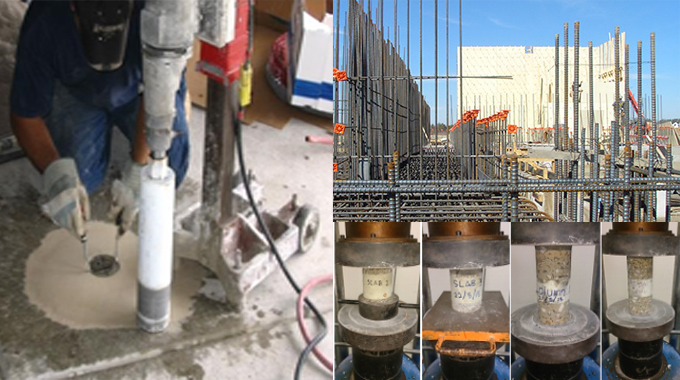
The types of tests on hardened concrete in structures
Different types of tests are conducted on Hardened Concrete to maintain the proper design strength and quality of concrete construction at optimal level.
Normal tests on Hardened Concrete:
The following primary destructive tests are performed on hardened concrete:
(a) Cube test: Compressive strength of hardened concrete is performed through cube test. Get more information on Compressive strength tests on Concrete Cube
(b) Tensile splitting test on concrete cylinders
(c) Flexure test: A plain concrete specimen is examined to failure in bending. The theoretical maximum tensile stress at the bottom face at failure is measured. This is called the modulus of rupture. It is around 1.5 times the tensile stress obtained with the splitting test.
(d) Concrete core test: A rotary cutting tool is used to slice cylindrical cores from the completed structure. The core is drenched, capped and examined in compression to get the quantity of the concrete strength in the original structure. The proportion of core height to diameter and the location, where the core is acquired, influence the strength. The strength is minimum at the top surface and raises with depth through the element. A proportion of core height-to-diameter of 2 provides a standard cylinder test. Get more information on Core Sampling and testing of concrete.
Non-destructive tests: The primary non-destructive tests for strength on hardened concrete areas are given below:-
(a) Rebound hammer (hardness) test
For the rebound hardness test, the schmidt hammer is utilized. Under this test, a metal hammer occupied against the concrete is sustained with another spring-driven metal mass and rebounds. The amount of rebound is documented on a scale and this highlights the strength of the concrete. As the rebound number is greater, the strength of the concrete will also increase.
(b) Ultrasonic pulse velocity test
Under the ultrasonic pulse velocity test, the velocity of ultrasonic pulses that transmit through a concrete section from a transmitter to a receiver is calculated. The pulse velocity is interrelated opposed to strength. If the velocity becomes higher, the strength of the concrete is increased.

(c) Other non-destructive tests: These tests are done through Equipment to compute the following :-
1. Crack widths and depths
2. Water permeability and the surface dampness of concrete
3. Depth of cover and the location of reinforcing bars
4. The electrochemical potential of reinforcing bars and therefore the existence of corrosion
Chemical tests on Concrete: There are a series of chemical tests to compute the following :-
1. Depth of carbonation
2. The cement content of the original mix
3. The content of salts like chlorides and sulphates which may react and result in decomposing of the concrete or erosion of the reinforcement.

